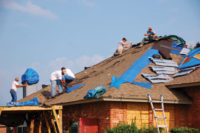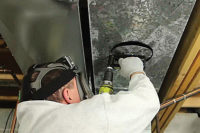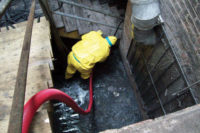Whether it’s to remove mold spores to eliminate the threat of cross contamination or to remove soot and smoke that made its way into the HVAC system after a fire loss, duct cleaning is an important step on many restoration projects. When it comes to performing this service, business owners have two options – they can choose to sub the duct cleaning work out to a qualified service provider or they can invest in the equipment, training and, in some cases, additional staff members to bring the service in house.
So what’s better? Subbing it or bringing it in house? Much of it depends on what type of a restoration company you are. For instance, if you do a lot of large loss work, you might elect to sub the service out to the professionals who can handle big commercial jobs. But if you’re mostly residential, perhaps there are benefits to bringing the service in house? Maybe you even do duct work on the side? But don’t take it from us – in order to give you a well-rounded scope of what route might be best for you, we reached out to four professionals in the industry, two who brought the service in house and two who sub the service out.
In House
Brent Pergrem, Owner, Slate Creek Contracting Services, Inc. (Owingsville, KY) has done duct cleaning in-house for about a year. But Pergrem didn’t invest in duct cleaning equipment to make more money or to market the service to clean ducts outside of his full-service restoration business. He invested in the equipment simply to control his projects better.
“It was really a quality control issue with us more than a financial decision,” he says. “We just knew that if we did it in house the way that we wanted it done, then our projects as a whole would be better. Adding the duct cleaning to our arsenal is just one more extension that we needed to just work more efficiently.”
One thing that Pergrem has discovered is that many of the companies that he could sub the service to don’t have the necessary experience in restoration. Plus, he dislikes the fact that when you sub out a service like duct cleaning, you deal with someone else’s time and someone else’s schedule.
“If you’re doing a mold remediation project, you have containment, there are environmental concerns to deal with other than just the duct cleaning,” Pergrem says. “Is your subcontractor going to be prepared to deal with those constraints? In my opinion, if you’re going to do duct cleaning, you need to understand other aspects of the business besides just duct cleaning – especially in the restoration world.”
While some may opt to bring duct cleaning in house to better manage projects, Jim Schuelke, Owner, Dry Right Restoration (Van Nuys, CA) has found another big benefit of doing so – more revenue.
“What we have found is that it’s a huge competitive advantage,” he says. “When you go into a home and you’re bidding it out, you include duct cleaning. The competitors don’t have it in house, so they don’t include it. And customers are wowed, we get a wow factor because the other guys didn’t think of that - they didn’t add that into their bid.”
Schuelke says that since they added duct cleaning over 2 years ago, the company’s mold and water damage conversions have greatly increased, which has thereby upped Dry Right’s annual revenue. Comparatively speaking, in the early days of the company when the service was subbed out, Dry Right ran into customer complaints and duct cleaners not showing up, all of which fell back onto them as a company.
Today, Schuelke says all of Dry Right’s techs are trained to use portable machines for duct cleaning and the equipment is included in every truck. Additionally, the clear vacuum head of the duct cleaning equipment that Dry Right deploys allows customers to see exactly what is coming out of their ducts, a feature Schuelke likes.
“We’re a visual company – we like to show our customers exactly what we’re doing,” he says.
Subbing It
“I’ve done the numbers on it and it is not cost effective for us, as a large restoration company, to actually put the capital outlay on a vehicle and then train staff to the right level that you’re meeting all the NADCA requirements for duct cleaning. The fundamental reason why is because of the standard turnover rate within our industry.”
That’s Joe Ledbetter, Director of Operations, BroadCo Property Restoration (Clinton Township, MI), a full-service restoration company that’s expected to do upwards of $25 million worth of work in 2014.
Aside from the high turnover within the industry and the constant need to re-train employees on proper duct cleaning protocol, Ledbetter also anticipates that he’d be losing money because duct cleaning work wouldn’t be necessary every day.
“I don’t have a task for them to be on every single day of the week, therefore the margins are depleted exponentially now because the unused time in which that vehicle is sitting is actually eating away from the margins on the job that it actually did perform,” he says.
But there’s another key reason why Ledbetter has opted to sub out the service – and that’s the amount of commercial work that BroadCo completes. He recalled a recent fire loss at a 30,000 square-foot high-end facility that he was on. Ledbetter says he called Amistee Air Duct Cleaning (Novi, MI) at 6 p.m. on a Friday, who in turn mobilized every asset they had to clean the ducts at the facility. As the ducts were being cleaned, Ledbetter says his team of 150 workers was executing the internal cleaning. Twelve hours later, the job was done, saving the insurance carrier between $75,000 and $100,000 in business interruption coverage.
“I couldn’t perform that task if I had chosen prior to bring that core service of duct cleaning into my wheel house,” he says. “I would have one truck and it would have taken the equivalent of 2-3 days to get through that entire job. I could have done it, but the problem is that I’m not presenting the savings to the carrier, which long-term is going to get me more jobs.”
Chris Empey, Chief Medic Officer, Property Medics (Bluffdale, UT) spent $100,000 on high-end duct cleaning equipment for his disaster restoration company, only to find that the work was few and far between and bringing the service in house was more hassle than it was worth.
“Simply put, duct cleaning was just not as profitable as it needed to be and we made the decision to divest in order to focus more limited resources to areas of greater potential and profitability,” he says.
While Empey admits that duct cleaning is a great value-added service when performed to the proper standard of care, he’s also quick to point out the challenges that his business faced when they were performing it in house. Namely, cross training of technicians and scheduling duct cleaning and restoration services using the same crew.
“To deliver the level of service we wanted to provide was costly compared with the return on investment,” he says.






Report Abusive Comment